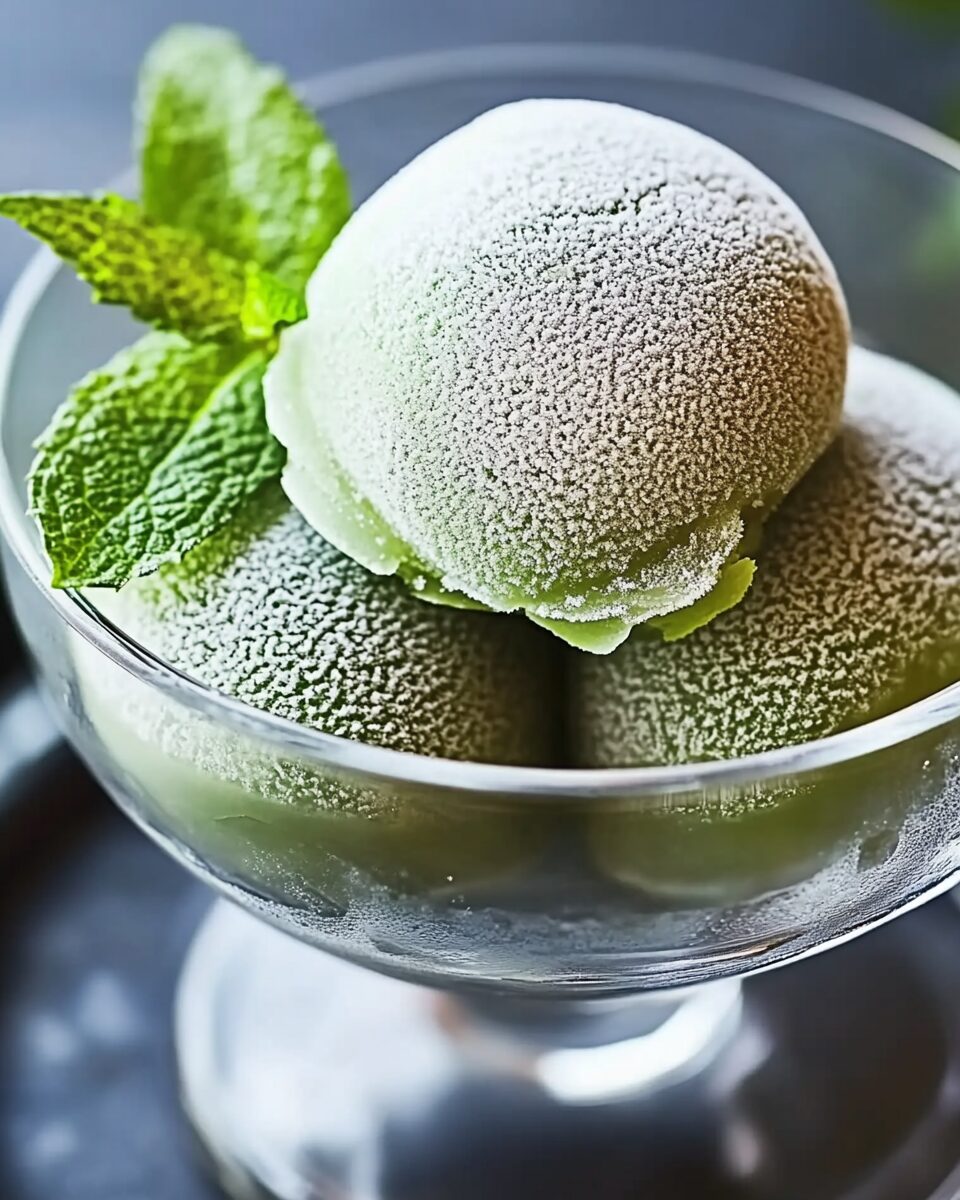Green Tea Mochi Ice Cream is a delightful fusion dessert that combines the chewy texture of mochi—a traditional Japanese rice cake—with the creamy, refreshing taste of green tea (matcha) ice cream. This treat offers a harmonious blend of flavors and textures, making it a popular choice among dessert enthusiasts worldwide.
Full Recipe:
Ingredients
- 10 small scoops of vanilla ice cream
- ½ cup sweet rice flour
- ½ cup cold water
- 1 pinch salt
- 2 tablespoons white sugar
- 1 teaspoon green tea powder (matcha)
- 1 tablespoon cornstarch, or as needed
Directions
-
Prepare the Ice Cream Balls
- Line 10 cups of a muffin tin or an egg carton with plastic wrap.
- Scoop small balls of vanilla ice cream into the prepared cups.
- Cover with plastic wrap and freeze until firm, at least 2 hours.
-
Make the Mochi Dough
- In a microwave-safe bowl, combine sweet rice flour, cold water, and a pinch of salt; stir until smooth.
- Add sugar and mix thoroughly.
- Whisk in green tea powder until fully incorporated.
-
Cook the Mochi Dough
- Cover the bowl with plastic wrap and microwave on high for 2 minutes.
- Stir the mixture, re-cover, and microwave for an additional 1 to 2 minutes until the dough is thick and slightly translucent.
-
Shape and Assemble the Mochi
- Dust a clean surface with cornstarch and turn the mochi dough onto it.
- Allow the dough to cool until it can be handled comfortably.
- Divide the dough into 10 equal pieces and flatten each into a circular shape.
- Place a frozen ice cream ball onto each mochi circle, wrap the dough around the ice cream, and pinch to seal.
- Wrap each mochi ice cream ball in plastic wrap and freeze until firm, about 2 hours.
Nutrients
Per Serving (1 mochi ice cream ball):
- Calories: 110
- Total Fat: 3g
- Saturated Fat: 2g
- Cholesterol: 10mg
- Sodium: 15mg
- Total Carbohydrates: 19g
- Dietary Fiber: 0g
- Sugars: 10g
- Protein: 1g
The Origins of Green Tea Mochi Ice Cream
Mochi has been a part of Japanese culinary tradition for centuries, often eaten during New Year celebrations and special occasions. Traditional mochi is made by steaming and pounding glutinous rice until it forms a smooth, sticky dough. It is then shaped into small cakes or wrapped around sweet fillings like red bean paste.
The concept of mochi ice cream, however, is a more modern innovation. It was developed in the 1980s by a Japanese-American entrepreneur who wanted to create a portable, bite-sized frozen dessert. The idea quickly gained popularity in the United States and eventually spread to other parts of the world. Green tea, or matcha, became one of the most popular flavors due to its rich, slightly bitter taste that perfectly balances the sweetness of the ice cream.
Why Green Tea Mochi Ice Cream is Popular
Green Tea Mochi Ice Cream has gained a devoted following for several reasons:
- Unique Texture Combination: The chewy mochi exterior contrasts beautifully with the creamy, cold ice cream inside, making each bite an exciting sensory experience.
- Balanced Flavor Profile: Matcha’s slightly earthy and bitter notes complement the sweetness of the ice cream, creating a well-rounded taste.
- Aesthetic Appeal: These small, round treats have a visually appealing appearance, often dusted lightly with cornstarch or powdered sugar for a polished finish.
- Convenient and Portable: Mochi ice cream is easy to eat on the go since it is served in small, individual portions that don’t require utensils.
- Gluten-Free Alternative: Since mochi is made from glutinous rice flour rather than wheat, it is naturally gluten-free, making it an excellent dessert choice for those with gluten sensitivities.
The Health Benefits of Green Tea Mochi Ice Cream
While Green Tea Mochi Ice Cream is a sweet indulgence, it also has some health benefits, primarily due to the inclusion of matcha:
- Rich in Antioxidants: Matcha is packed with catechins, a type of antioxidant that helps protect the body from oxidative stress and may support overall health.
- Boosts Metabolism: Some studies suggest that green tea can aid metabolism, making matcha a common ingredient in health-conscious diets.
- Supports Brain Function: Matcha contains L-theanine, an amino acid that promotes relaxation and mental clarity without the jitters associated with caffeine.
- Dairy-Free Options Available: While traditional Green Tea Mochi Ice Cream is made with dairy-based ice cream, there are many plant-based alternatives that use coconut milk or almond milk for a lactose-free version.
Variations of Green Tea Mochi Ice Cream
While the classic version of Green Tea Mochi Ice Cream remains a favorite, there are several variations that add new flavors and textures:
- Chocolate-Dipped Mochi Ice Cream: Some variations feature a thin chocolate coating around the mochi for an extra layer of flavor and texture.
- Filled Mochi Ice Cream: Some versions include additional fillings such as red bean paste, fruit purees, or caramel for a surprise flavor inside.
- Flavored Mochi Dough: Instead of plain mochi dough, some recipes incorporate extra matcha powder, vanilla, or even fruit extracts for enhanced flavor.
- Toppings and Garnishes: Green Tea Mochi Ice Cream is sometimes served with drizzles of honey, sesame seeds, or crushed nuts for added texture and taste.
Best Occasions to Serve Green Tea Mochi Ice Cream
This dessert is versatile and suitable for various occasions, including:
- Summer Refreshments: The cool, refreshing nature of mochi ice cream makes it perfect for hot summer days.
- Tea Time Pairing: It pairs well with hot or iced green tea, creating a cohesive flavor experience.
- Dinner Party Dessert: Mochi ice cream is an elegant, bite-sized dessert that impresses guests without being too heavy.
- Celebrations and Festivals: Given its Japanese heritage, Green Tea Mochi Ice Cream is often enjoyed during special events, holidays, and cultural festivals.
Tips for Making the Best Green Tea Mochi Ice Cream
For those making Green Tea Mochi Ice Cream at home, here are some essential tips:
- Work Quickly with Ice Cream: The ice cream must be well-frozen before wrapping it in mochi dough to prevent melting. Keeping hands cold while working with the ice cream also helps.
- Dust with Cornstarch or Potato Starch: Mochi dough is naturally sticky, so dusting the work surface and hands with starch prevents sticking.
- Use High-Quality Matcha: The flavor of matcha varies depending on its quality. For a vibrant green color and a richer taste, use ceremonial-grade matcha rather than lower-quality versions.
- Freeze Properly After Assembly: Once the mochi ice cream is assembled, it should be frozen for a few hours to ensure the ice cream stays firm and the mochi layer sets properly.
How Green Tea Mochi Ice Cream Compares to Other Mochi Desserts
Mochi is a highly versatile ingredient used in various desserts, and Green Tea Mochi Ice Cream is just one of many ways to enjoy it. Here’s how it compares to other popular mochi-based treats:
- Traditional Mochi: Made purely from glutinous rice, traditional mochi is often filled with sweet red bean paste or eaten plain. It has a chewier texture than mochi ice cream.
- Daifuku: A type of stuffed mochi that can be filled with sweet pastes, custards, or even fresh fruit.
- Mochi Waffles or Pancakes: Some modern adaptations of mochi use glutinous rice flour in batter form to create chewy waffles or pancakes.
- Butter Mochi: A Hawaiian dessert that combines butter, coconut milk, and mochiko flour for a rich, cake-like texture.
Conclusion
Green Tea Mochi Ice Cream is a delicious and unique dessert that perfectly blends the traditional Japanese mochi with the smooth, refreshing taste of matcha ice cream. Its combination of chewy and creamy textures, balanced flavors, and aesthetic appeal make it a favorite treat worldwide.
Beyond its indulgent taste, this dessert also offers health benefits, thanks to matcha’s antioxidant properties. Whether enjoyed as a refreshing summer snack, a sophisticated tea-time pairing, or an elegant dinner party dessert, Green Tea Mochi Ice Cream is a versatile and satisfying treat.






